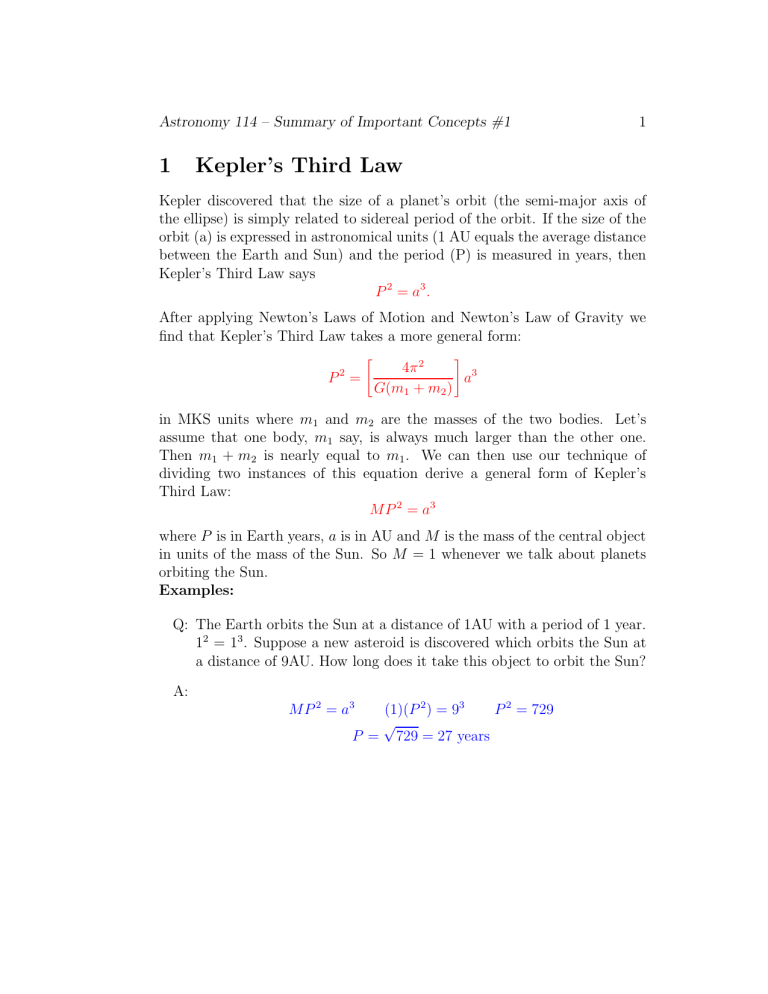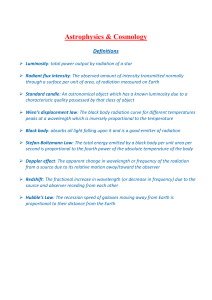
Astronomy 114 – Summary of Important Concepts #1 1 1 Kepler’s Third Law Kepler discovered that the size of a planet’s orbit (the semi-major axis of the ellipse) is simply related to sidereal period of the orbit. If the size of the orbit (a) is expressed in astronomical units (1 AU equals the average distance between the Earth and Sun) and the period (P) is measured in years, then Kepler’s Third Law says P 2 = a3 . After applying Newton’s Laws of Motion and Newton’s Law of Gravity we find that Kepler’s Third Law takes a more general form: " # 4π 2 P = a3 G(m1 + m2 ) 2 in MKS units where m1 and m2 are the masses of the two bodies. Let’s assume that one body, m1 say, is always much larger than the other one. Then m1 + m2 is nearly equal to m1 . We can then use our technique of dividing two instances of this equation derive a general form of Kepler’s Third Law: M P 2 = a3 where P is in Earth years, a is in AU and M is the mass of the central object in units of the mass of the Sun. So M = 1 whenever we talk about planets orbiting the Sun. Examples: Q: The Earth orbits the Sun at a distance of 1AU with a period of 1 year. 12 = 13 . Suppose a new asteroid is discovered which orbits the Sun at a distance of 9AU. How long does it take this object to orbit the Sun? A: M P 2 = a3 (1)(P 2 ) = 93 P 2 = 729 √ P = 729 = 27 years Astronomy 114 – Summary of Important Concepts #1 2 2 Newton’s Law of Gravitation Any two objects, no matter how small, attract one another gravitationally. The attractive force depends linearly on the mass of each gravitating object (doubling the mass doubles the force) and inversely on the square of the distance between the two objects F =− Gm1 m2 . r2 G is the gravitational constant which is just a number which makes the results of the equation match-up with our systems of measurement. The ‘−’ sign indicates that the force is attractive. Example: Q: Halley’s Comet travels on an eccentric elliptical orbit which carries it as close as about 1AU to the Sun and as far as about 20AU. Compare the gravitational force between Halley’s Comet and the Sun at these extremes in its orbit. A: The comet changes its distance from the Sun by a factor of 20. Since the gravitational force depends on the inverse square of the distance, then the force when the comet is far from the Sun is 202 or 400 times weaker than when the comet is near the Sun. 3 The Propagation of Waves Waves of light, sound, or even water each have a well defined frequency (ν) and wavelength (λ). If you think carefully about the definition of these two numbers it should be obvious that their product is the velocity of propagation of the waves: λν = c where c is the symbol for the velocity of the wave. For light c=300,000 km/s. Example: Q: On a quiet pond you observe water waves with a wavelength of 10 cm which pass a floating cork at the rate of 2 wave crests per second. How fast are the waves moving along the water? Astronomy 114 – Summary of Important Concepts #1 3 A: The frequency of the waves is 2 per second and their wavelength is 10 cm. 10 cm × 2/second = 20 cm/second. Note how important proper units are to the final answer. 4 The Energy Carried by a Photon Each packet of electromagnetic energy, or photon, carries a specific amount of energy which is simply related to the photon’s frequency (ν) and wavelength (λ). hc E = hν = λ The formula shows that high frequency (short wavelength) photons carry the most energy. Low frequency (long wavelength) photons are the least energetic. The constant, h, is called Plank’s constant and once again its purpose is to scale the equation so that it agrees with our system of measurement. Example: Q: Which type of photon carries the most energy, ultraviolet photons or gamma rays? A: Since gamma rays have a much higher frequency than ultraviolet light they carry the most energy per photon. 5 Blackbody Radiation A blackbody is an object that appears perfectly black (reflects no radiation at all) when cold (at absolute zero!). There are virtually no perfect blackbodies in the real world. On the other hand, almost any solid object has properties very similar to perfect blackbodies. Common everyday experience tells you that when you heat something up it begins to glow, first a dull red, then yellow, then white hot, and eventually even blue. Two laws describe the color and quantity of radiation emitted by a blackbody at a given temperature: Astronomy 114 – Summary of Important Concepts #1 6 4 Wien’s Law This law permits you to calculate the peak wavelength (i.e. color) of the continuous spectrum emitted by a hot object if you know the temperature. λmax = 0.29cm T (◦ K) peak wavelength = 0.29cm T emperature in Kelvins Remember red light has a wavelength of 700 nm = 7×10−5 cm and blue light has a wavelength of 400 nm = 4×10−5 cm. Examples: Q: The temperature of the Sun is about 5800◦ K. What is the peak wavelength of its blackbody spectrum? A: λmax = 0.29cm 0.29cm = = 5 × 10−5 cm or 500nm ◦ T ( K) 5800K 500 nm is the wavelength of yellow light and indeed the Sun appears yellow. Q: Star A is twice as hot as Star B. Star B appears red (λmax = 700 nm). What color is Star A? A: Since the peak wavelength depends inversely on the temperature, if the temperature doubles the peak wavelength is halved. 700 nm/2=350 nm. Light with a wavelength of 350 nm is blue. 7 The Stefan-Boltzmann Law This law quantifies the amount of energy emitted by one unit of surface area of a hot blackbody per second. Energy flux = σT4 . Note that the amount of energy emitted depends very strongly on the temperature. Example: Q: How much more energy does a blackbody emit if its temperature triples? A: Since E=σT4 the increase in emitted energy is 34 or 3 × 3 × 3 × 3=81. Astronomy 114 – Summary of Important Concepts #1 8 5 The Luminosity of a Star The luminosity of a star is a measure of the total amount of energy it emits. Since stars behave like blackbodies we can use the Stefan-Boltzmann law for the amount of energy emitted by one square centimeter of the surface of the star with the equation for the surface area of a sphere. The surface area of a sphere, i.e. the number of square centimeters emitting radiation, is 4πR 2 where R is the radius of the star. Thus the luminosity of a star is L = (surf ace area)(energy emitted) = (4πR 2 )(σT 4 ). Examples: Q: Suppose the size of a star doubles while it maintains the same temperature. How does the luminosity of the star change? A: Since the luminosity depends on the radius squared the new luminosity will be 22 = 2×2 = 4 times greater. If the radius tripled instead, the luminosity would increase by a factor of 9. Two stars have the same size. One star is 3 times hotter than the other. How much more luminous is the second star? The luminosity of a star depends on the temperature raised to the fourth power. If the temperature increases 3 times the luminosity increases by 3 4 = 3 × 3 × 3 × 3=81. For additional review questions, check the ends of chapters in your textbook!


